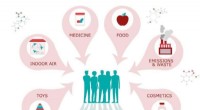
Wetenschap
EPA-actie stimuleert het momentum om giftige chemicaliën voor altijd te verminderen

Krediet:Pixabay/CC0 Publiek domein
De inlaatpompen die ooit 6 miljoen gallons water per dag uit de Oostanaula-rivier haalden, slapen nu grotendeels in deze stad in het noordwesten van Georgia.
Lokale functionarissen beweren dat jaren van besmetting mijlen stroomopwaarts giftige perfluoralkyl- en polyfluoralkylstoffen, bekend als PFAS, in de watervoorziening van Rome hebben gestuurd, waardoor het potentieel gevaarlijk wordt voor de ongeveer 37.000 inwoners van de stad. Een waterbronwissel van de Oostanaula en toegevoegde behandeling hebben de sporen van de chemicaliën die door de kranen van de bewoners lopen verminderd, maar ze hebben PFAS niet geëlimineerd uit de watervoorziening van de gemeenschap.
Testresultaten die besmetting in Rome aantoonden, hebben weerklank gevonden in gemeenschappen in het hele land, terwijl onderzoekers en regelgevers worstelen met zorgen over de implicaties van het consumeren van de alomtegenwoordige chemicaliën. Nu versnelt de Environmental Protection Agency het debat. In juni heeft de EPA nieuwe adviezen uitgebracht over PFAS in drinkwater die het niveau verlagen dat regelgevers als veilig beschouwen voor vier chemicaliën in de familie, waaronder twee van de meest voorkomende, PFOA en PFOS.
De gezondheidsadviezen van de EPA zijn niet wettelijk afdwingbaar. Maar het bureau zal naar verwachting dit jaar nieuwe limieten voor PFAS in openbare watersystemen voorstellen. Als die drinkwatervoorschriften de laatste adviezen van de EPA weerspiegelen, zullen watersysteembeheerders in het hele land moeten optreden om de aanwezigheid van die chemicaliën aan te pakken.
"Het is een vrij belangrijke boodschap", zegt Dr. Philippe Grandjean, een PFAS-expert en een adjunct-professor milieugezondheid aan de Harvard T.H. Chan School of Public Health. "Dit spul is overal.''
De Environmental Working Group, een onderzoeks- en belangenorganisatie die PFAS volgt, zei dat het meer dan 2.800 locaties in de VS heeft geregistreerd met PFAS-besmetting. Uit openbare registers blijkt dat de chemicaliën zijn aangetroffen in watermonsters die zijn verzameld in waterbronnen, kerken, scholen, militaire bases, verpleeghuizen en gemeentelijke watervoorzieningen in kleine steden als Rome en grote steden als Chicago.
Ze zijn ook aanwezig in bijna het bloed van elke Amerikaan, volgens studies. En sommige PFAS-verbindingen bioaccumuleren, wat betekent dat chemische concentraties niet gemakkelijk in het lichaam worden geklaard en in plaats daarvan in de loop van de tijd toenemen naarmate mensen elke dag sporen consumeren.
In juli zei een rapport van de National Academies of Sciences, Engineering en Medicine dat PFAS-tests moeten worden aangeboden aan mensen die waarschijnlijk zijn blootgesteld aan hoge niveaus door hun werk of mensen die in gebieden wonen met bekende PFAS-besmetting. Grandjean, who helped review the report for the National Academies, said the committee concluded that "people have a right to know their exposure level and to be offered proper health care follow-up." He said that doing so is "very important and, in my mind, necessary."
Both the EPA advisories and the National Academies' report follow steady grassroots efforts to curb PFAS chemicals, which have been used in consumer products for decades. Since their invention in the 1940s, the compounds—known by the moniker "forever chemicals" because they don't break down quickly—have been widely applied to household and industrial products, including carpet, waterproof clothes, and nonstick cookware.
PFAS' presence in firefighting foam, food packaging, and even dental floss poses an ongoing challenge. And efforts to reduce PFAS resemble the often-frustrating, decades-long campaign to eliminate another environmental hazard—lead—from homes, soil, and water.
"There has been a dramatic increase in advocacy and public awareness about PFAS," said Alissa Cordner, an expert on the chemicals and an environmental sociology professor at Whitman College in Walla Walla, Washington.
In their report, researchers for the National Academies said they found links between exposure to PFAS and four health conditions:decreased immune response, elevated cholesterol, decreased infant and fetal growth, and increased risk of kidney cancer. The report also found a possible association between the chemicals and breast cancer, changes in liver enzymes, increased risk of testicular cancer, and thyroid disease.
And EPA officials said the agency's latest advisories are based on new science and account for indications "that some negative health effects may occur with concentrations of PFOA or PFOS in water that are near zero."
Most states don't regulate PFAS, though.
That makes the EPA advisories important, said Jamie DeWitt, a professor of pharmacology and toxicology at East Carolina University. "The message from the EPA is that if these PFAS can be detected in drinking water, they pose health risks," she said.
The American Chemistry Council, an industry trade group, pushed back against the advisories and recently asked a federal court to vacate them, saying that the agency process was "scientifically flawed and procedurally improper" and set "impossibly low standards for PFOA and PFOS in drinking water." In a June statement, the council said PFAS have important uses, including in renewable energy efforts and medical supplies.
One producer of PFAS, 3M, said in a statement that the company "acted responsibly in connection with products containing PFAS and will vigorously defend its record of environmental stewardship."
The compounds' development took off with initial hits in Teflon and later Scotchgard. There are 12,000 variations of them now, but only about 150 are being studied by scientists and government agencies, DeWitt said.
U.S. manufacturers voluntarily phased out PFOS and PFOA, the two most extensively produced, but they're still found in drinking water. The city of Rome is among 10 North Georgia communities where PFOS or PFOA have been found in drinking water supplies at higher levels than the EPA advisories declare is safe, the state's environmental regulatory agency said.
Six years ago, officials in Rome were forced to switch the city's water supply from the Oostanaula to the nearby Etowah River, a brownish tributary that merges with the Oostanaula near a downtown bridge. Years of chemical contamination in the Oostanaula that Rome officials said begins dozens of miles upstream in Dalton made the water potentially dangerous. They said that in Dalton, the epicenter of U.S. carpet manufacturing, industrial waste containing PFAS has leached into the Conasauga River, which flows into the Oostanaula.
Officials in Rome plan to build a $100 million reverse-osmosis filtering system to remove the chemicals from the city's water supply. Ratepayers will foot the bill, although a lawsuit filed by the city against carpet manufacturers and their chemical suppliers aims to recover those costs. A separate lawsuit filed by a Rome resident and ratepayer levies similar accusations against the upstream companies. Defendants in the two Rome-based suits have denied the allegations.
The EPA announced $1 billion in grant funding so states can address PFAS and other contaminants in drinking water. But modifications to public water systems nationwide will likely outstrip that allocation quickly.
Downstream from Rome, officials in the Alabama cities of Centre and Gadsden have reported high levels of PFAS in the Coosa River and filed lawsuits against carpet makers. The Gadsden lawsuit is expected to go to trial in October.
The chemicals have drawn a flurry of litigation over the past two decades. A Bloomberg Law analysis found more than 6,400 PFAS-related lawsuits filed in federal courts between July 2005 and March 2022.
Substantial payouts have followed. DuPont and Chemours, which made PFAS products for decades, settled more than 3,500 lawsuits in 2017 for more than $670 million. Both companies denied wrongdoing. And 3M settled a lawsuit from the state of Minnesota for $850 million. The same company settled litigation in the Decatur, Alabama, area for $98 million.
The EPA now should cast a broader net to consider the wide variety of the chemicals, Cordner said. "The persistence of PFAS means we'll be dealing with this for a long time," she said. "Because of their sheer quantity, we need to treat PFAS as a class. We can't go chemical by chemical."
EPA spokesperson Tim Carroll said in an email to KHN that the agency is working to divide the large class of PFAS into smaller categories based on similarities such as chemical structure, physical and chemical properties, and toxicological properties. That work, he said, would "accelerate the effectiveness of regulations, enforcement actions, and the tools and technologies needed to remove PFAS from air, land, and water."
In the meantime, some companies and the military have moved to stop using the chemicals.
The Green Science Policy Institute, an environmental advocacy group, has developed a list of PFAS-free products, including rain gear and apparel, shoes, baby products, cosmetics, and dental floss.
Two years ago, Home Depot and Lowe's said they wouldn't sell carpets or rugs with PFAS in them. This year, the textile manufacturer Milliken said it would eliminate all PFAS from its facilities by the end of 2022.
A handful of flooring companies have followed suit. Dalton-based Shaw Industries, a defendant in the Rome lawsuits, said it has stopped using PFAS in soil and stain treatments for residential and commercial carpet products.
The Coosa River Basin Initiative, a Rome-based environmental advocacy organization, has been tracking the PFAS issue closely. Its executive director, Jesse Demonbreun-Chapman, said the EPA has moved "at lightning speed'' on PFAS, compared with other agency actions.
But unless the eventual regulations are sweeping and the cleanups extensive, he said, "we the people will be guinea pigs for PFAS-related health problems." + Verder verkennen
It's raining PFAS:Even in Antarctica and on the Tibetan Plateau, rainwater is unsafe to drink
2022 Kaiser Health News.
Gedistribueerd door Tribune Content Agency, LLC.
 Laserstraalexcitatie heeft geen invloed op de nucleofiele substitutiereactie
Laserstraalexcitatie heeft geen invloed op de nucleofiele substitutiereactie Onderzoekers printen kanaalstructuren in kwartsglas
Onderzoekers printen kanaalstructuren in kwartsglas Wetenschappers persen katalysatoren in gastheermaterialen zoals een schip in een fles
Wetenschappers persen katalysatoren in gastheermaterialen zoals een schip in een fles Verslaving behandelen:Cryo-EM-technologie maakt het onmogelijke mogelijk
Verslaving behandelen:Cryo-EM-technologie maakt het onmogelijke mogelijk Nuttige microben inhaleren koolstofdioxide via een poreuze cilindrische elektrode en scheiden nuttige chemicaliën uit
Nuttige microben inhaleren koolstofdioxide via een poreuze cilindrische elektrode en scheiden nuttige chemicaliën uit
 Variabiliteit per provincie van de opbrengst van bio-energiegewassen in de VS
Variabiliteit per provincie van de opbrengst van bio-energiegewassen in de VS NASA ziet tropische cycloon Iris voor de kust van Queensland verzwakken
NASA ziet tropische cycloon Iris voor de kust van Queensland verzwakken De ongebruikelijke verbinding tussen bevers,
De ongebruikelijke verbinding tussen bevers,  Meer reactieve landoppervlakken koelden de aarde af
Meer reactieve landoppervlakken koelden de aarde af Opinie:schrap zetten voor de kosten van klimaatverandering
Opinie:schrap zetten voor de kosten van klimaatverandering
Hoofdlijnen
- Hoe gigantische tropische fruitvleermuizen te redden:werk samen met lokale jagers die vleermuistanden als geld gebruiken
- Wormsoorten verloren 7, 000 genen na evolutie om zichzelf te bevruchten
- Kinesins negeren zwakke krachten omdat ze zware lasten dragen
- Waarom zijn er 61 Anticodonen?
- Waarom zijn mensen hun staart kwijtgeraakt?
- Morfogenese en de ontwikkeling van levende vormen
- Onderzoekers genereren tomaten met verbeterde antioxiderende eigenschappen door genetische manipulatie
- Hoe eetbare plantencellen te maken
- Colombia - een megadivers paradijs dat nog ontdekt moet worden
- Aanpak van de veiligheid van gecombineerde blootstelling aan meerdere chemicaliën voor mens en milieu

- Om de klimaatdoelstellingen van Parijs te halen, is een substantiële herverdeling van wereldwijde investeringen nodig

- NASA-satellietbeelden vinden Rebekah nu post-tropisch

- De opname van koolstofdioxide in de oceaan kan afnemen als de koolstofemissies worden verminderd

- Van zware metalen tot COVID-19, Rook van bosbranden is gevaarlijker dan je denkt

 Enorme exoplaneet ontdekt met behulp van zwaartekracht-microlensmethode
Enorme exoplaneet ontdekt met behulp van zwaartekracht-microlensmethode VK, VS lanceren grootste studie ooit van Antarctische gletsjer
VK, VS lanceren grootste studie ooit van Antarctische gletsjer Afbeelding:3D-geprint satellietbeeldontwerp
Afbeelding:3D-geprint satellietbeeldontwerp Geoptimaliseerde analyses verminderen valse negatieven bij de detectie van nanodeeltjes
Geoptimaliseerde analyses verminderen valse negatieven bij de detectie van nanodeeltjes Italiaanse gletsjer bedekt om langzaam te smelten
Italiaanse gletsjer bedekt om langzaam te smelten Wiskunde kan steden helpen bij het aanpakken van ongestructureerde buurten
Wiskunde kan steden helpen bij het aanpakken van ongestructureerde buurten Bossen gebruiken om koolstof te beheren - een verhit debat
Bossen gebruiken om koolstof te beheren - een verhit debat Nieuw mechanisme van optische versterking in tweedimensionaal materiaal vereist slechts een extreem laag ingangsvermogen
Nieuw mechanisme van optische versterking in tweedimensionaal materiaal vereist slechts een extreem laag ingangsvermogen
- Elektronica
- Biologie
- Zonsverduistering
- Wiskunde
- French | Italian | Spanish | Portuguese | Swedish | German | Dutch | Danish | Norway |

-
Wetenschap © https://nl.scienceaq.com

